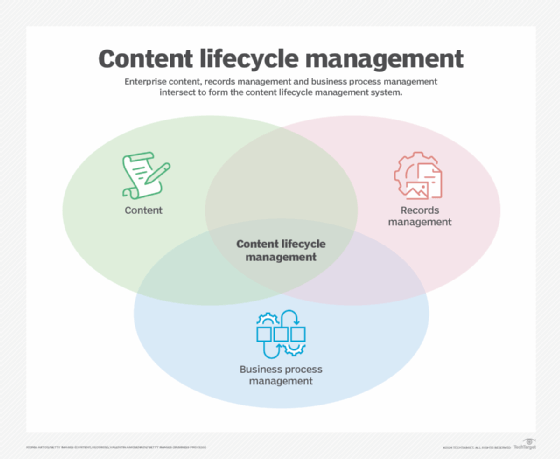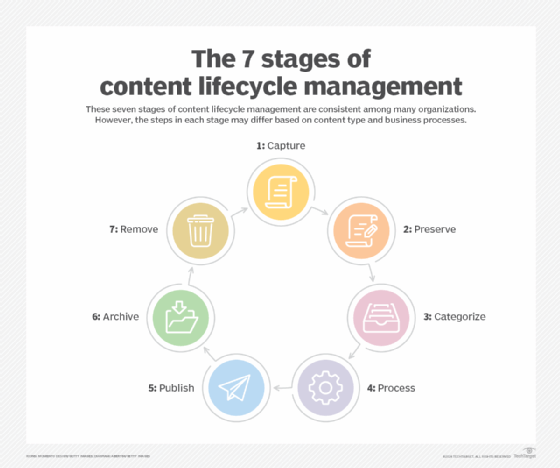The 7 stages of enterprise content lifecycle management
Content lifecycle management is where business process management, content and records management intersect. Learn more about this process and its key stages.
Enterprise content lifecycle management is not new. What is new, however, is the volume and accessibility of digital content in the enterprise.
For today's businesses, it's easy for digital content to become unorganized, muddled or hard to find. Content lifecycle management drives efficiency in content-related workflows and takes advantage of shared knowledge.
Organizations must recognize the different stages of content lifecycle management. Then, they can capture knowledge from multiple sources and bring it into a predictable and reliable content system.
What is content lifecycle management?
Enterprise content lifecycle management is the intersection of business process management, content creation and records management, which are three key concepts for many businesses. Content lifecycle management is the set of process-related actions that need to take place for investments in enterprise content management (ECM) systems and applications to pay dividends.
Content can be categorized in different ways. But, at a basic level, content fits into the following types:
- Dynamic content changes according to user input. It's typically related to a business process and contains data such as names, dates and locations. It also contains other identifying information that determines workflows, such as whether the content is active or published. This content may come from disparate business systems, or end users may enter and maintain it. There may be multiple content lifecycle management processes within each business process that manages the data. Examples of dynamic content include product pages, websites, forms, ads and email newsletters.
- Static content is an asset that doesn't change due to a user's actions. It includes the process of creating and refining a point in time as a snapshot or record. Generally, artifacts and records are the result of or contain dynamic content and are relied upon for historical reference. Examples of static content include a logo, website navigation bar and legal artifacts such as a will or power of attorney.
A growing number of online content management systems (CMSes) can collect dynamic content and create artifacts. Content lifecycle management ensures the CMS has the correct and best information for the ECM system to store dynamic content and its resulting artifacts.
This article is part of
What is enterprise content management? Guide to ECM

Why is content lifecycle management important?
Content management serves as the foundation for most business strategies that are directly related to reduced risk, higher efficiency and a better product.
When thinking about dynamic content management, the ability to reliably automate workflows depends on the quality of the content used to drive those workflows. End users need to trust that when workflows generate email, for example, they are going to the right people with the correct information. If dynamic content is incorrect, automated processes break, trust breaks down and there may even be security or regulatory repercussions.
Artifact content such as email, executed documents and blog posts present similar opportunities and challenges. Artifacts can create business records to support sales or internal processes, which can enforce business standards and improve efficiency. For example, it's more efficient to find a project kickoff presentation rather than recreating the content. It also ensures that an organization covers all topics and follows policies and procedures.
In all instances, content lifecycle management is a requirement for governance, risk and compliance and for any knowledge management initiatives a business is engaged in.
What are the benefits of content lifecycle management?
To understand the benefits of content lifecycle management, consider the earlier example of the legal industry -- specifically, creating a will.
The "old-fashioned" way to do this would be to do the following:
- Meet with the client and ask questions based on past experience.
- Search for documents or templates that fit the specific requirements.
- Draft a document combining the client input and the template.
- Review the document and create a final draft for client approval.
In this scenario, the quality of the final document depends on the attorney's experience level and the quality of the templates.
This same process using content lifecycle management and a CMS might work as follows:
- Use a questionnaire or checklist that is grouped to drive content by category.
- Input this content into a system that generates a set of artifacts that rely on underlying information to decide what type of document to create.
- Use additional metadata information -- such as client name, beneficiaries and addresses -- to fill any blanks in the document and create a draft for review.
This approach provides better quality through shared knowledge and does it more efficiently with less cost.
What are the stages of content lifecycle management?
The content lifecycle generally involves seven steps. While each stage of the content lifecycle is consistent, the phases or steps for each stage may differ based on the type of content and the business processes.

Organizations should consider these stages and phases to be checklists for auditing their own process rather than detailed steps.
- Capture. The capture stage of content lifecycle management can happen at varying times in each organization's specific process. Captured content includes scanned images, word processing documents and metadata. Scanning and authoring tools usually support this step in the process. At this stage, organizations should recognize where their content is sourced and ensure that content acquisition is easy.
- Preserve. Deciding where and how an organization stores its captured content affects how useful it is in other processes. Here are some considerations for content storage:
- Templates -- such as wills -- must be editable. If another process automatically generates a document, it must be "smart," meaning it must allow information from other systems to fill out variables.
- Organizations must publish some documents -- particularly legal documents -- as a record. They should not be editable and generally include either a physical or electronic signature or other acceptance. This means the actual artifact may include both a file and other metadata.
- Categorize. The categorization or grouping of content enables repurposing, maintenance and compliance review. Organizations can achieve this by simply using a directory structure. ECM systems provide more sophisticated approaches using metadata and enabling one-to-many and many-to-many relationships of content to purpose. Content team members should use a strong enterprise taxonomy to ensure standardized categorization across the organization.
- Process. Process mapping for content includes several considerations. Organizations must determine the following:
- Which documents to review for accuracy and their review cycles.
- The purpose of content as parts of larger processes. For example, in a sales process, a final contract might trigger additional processes that affect other content or systems.
- Retention policy processes that follow regulatory requirements.
Process mapping is generally based on one or more categories applied during the grouping stage.
- Publish. The publishing content phase differs depending on content type, grouping and process. The most common publishing process might be in a web content management system where marketing, product or other website content may go through multiple revisions and approval processes prior to publication. WCMS or ECM systems manage the visibility of content through a publishing process.
- Archive. Archiving content is a practice that should simplify identifying "good" content to only include currently approved content or content with decision-making purposes. Archiving enables users to refer to the content if necessary without cluttering end-user systems.
- Remove. The actual removal of content is a particularly important step for system maintenance, governance, risk and compliance.
What are content lifecycle management best practices?
Organizations should consider these best practices to ensure content lifecycle management is integrated smoothly into the business as part of their content strategy:
- Follow existing standards and practices. Introducing content lifecycle management as a new concept rather than a natural extension of business goals is usually met with pushback. Whenever possible, organizations should use existing end-user interfaces and touchpoints to establish a content lifecycle management process.
- Support the natural way the company does business. If content lifecycle management enforces workflows or new content types that do not fit the business, it won't work. For example, if a law firm requires a paper copy of a signed will and its content lifecycle management process does not support scanning or paper capture, the organization won't adopt that process. Trying to convince an attorney or client that they don't need a paper copy won't likely succeed.
- Tailor content lifecycle management to specific job roles. When interacting with a piece of content, organizations should not present users with options or decisions that create confusion or don't make sense to their jobs. This presents an opportunity for users to find ways to bypass the system.
- Build in governance, risk and compliance. Governance, risk and compliance cannot be an afterthought. Losing protected information and data is one of the greatest threats facing a business. Content lifecycle management is key to ensuring an organization only uses content as intended.
Editor's note: This article was updated to improve the reader experience.
Jonathan Bordoli is an experienced technical project manager and solution architect. He has more than 25 years of experience defining, designing and managing technology delivery across the full project lifecycle.








